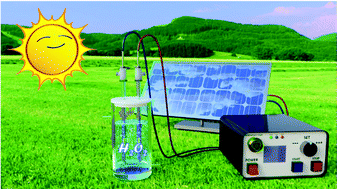Sustainable plasma-catalytic bubbles for hydrogen peroxide synthesis†
Abstract
Hydrogen peroxide (H2O2) is a green oxidant widely used in various fields, from water treatment to rocket propellant. Currently, H2O2 is predominantly manufactured via the anthraquinone process, which requires large infrastructure investments and high energy consumption. In this study, an argon plasma-catalytic bubble process was designed to generate underwater plasma bubbles for efficient delivery of reactive species for H2O2 synthesis, using only water as a reactant and solar radiation as the renewable energy source. The process demonstrates unprecedented energy efficiency by employing a plasma-bubble catalytic reactor capable of operation in two discharge modes, i.e., glow and spark discharges, and using dual reactors within a single AC-circuit to mitigate energy losses around the ground electrode. The results suggest that the principal route of H2O2 generation is from the combination of dissolved ˙OH radicals at the plasma–liquid interface (PLI) of the forming bubbles. The dissolution of H2O2 formed in the gas phase also contributes to aqueous H2O2 generation, especially when employing humid argon. By employing a secondary reactor to utilise the lost energy around the low-voltage electrode and integrating a strongly interfacial-coupled 2D-TiO2/2D-g-C3N4 photocatalyst in the glow discharge area, the achieved H2O2 production rate and energy efficiency of the system are 164.6 mg h−1 and 9.0 g kW h−1, respectively. This study provides new insights for sustainable and decentralised H2O2 production, and the proposed strategy can be further developed as a stand-alone or auxiliary technology in green and sustainable chemistry.



 Please wait while we load your content...
Please wait while we load your content...